COMMELINA
Commelina
Plum. ex L., Sp. Pl. 1: 40. 1753; Gen. Pl. ed. 5: 25. 1754; Benth. & Hook. f., Gen. Pl. 3: 847. 1883; Boiss., Fl. Or. 5:345; 1881 (as Commelyna); Clarke in DC., Monogr. Phantom. 138: 1881; Hook. f., Fl. Brit. India 6: 368. 1894; T. Cooke, Fl. Born. Pres. 3: 288. 1907; Bruck. in Engl. & Prantl., Natur. Pflanzenfam. ed. 2, 15 a: 177. 1930; Fl. China @ eFloras.org 24: 35; Fl. North Amer. @ eFloras.org vol. 22; Fl. Pak. @ eFloras.org p. 9.
Perennial or annual herbs, stem slender, creeping, ascending or erect, glabrous or pubescent. Rhizome absent. Leaves 2-ranked or spirally arranged; blades sessile or petiolate, entire, sheathing at base. Inflorescences terminal, leaf-opposed, cincinni (scorpoid cymes), 1-2 cymes enclosed in spathes; proximal cymes several-flowered, distal cyme vestigial or with 1-many staminate flowers, spathes often filled with mucilaginous liquid, margins distinct or basally connate; bracteoles usually absent. Flowers bisexual and staminate, bilaterally symmetric, pedicels well-developed. Sepals 3, unequal, free or proximal 2 connate below, the distal cucullate, free. Petals 3, free, longer than sepals, proximal petal often of different colour than distal 2, smaller or subequal, distal 2 blue (occasionally lilac, lavender, yellow, peach, apricot or white), clawed. Stamens (5-)6, proximal 3 fertile, free, antisepalous, medial different in form, size from others, distal (2-)3 staminodial; filaments glabrous, antherodes commonly 4-6-lobed. Ovary 2-3-locular, ovules 1-2 per loculus, 1-seriate. Capsules loculicidal, 2-3-valved, 2-3-locular. Seeds1-2 per loculus.
201 species
Commelina benghalensis
Commelina benghalensis
L., Sp. Pl. 1: 41. 1753; Gen. Pl. ed. 5: 25. 1754; Clarke in DC., Monogr. Phan. 159: 1881; Hook. f., Fl. Brit. India 6: 370. 1894; Collett, Fl. Siml. ed. 2: 532. 1921 (Reprint 1983); Maheshwari, Illustr. Fl. Delhi: f. 203. 1966; Kaur & Sharma, Fl. Sirmaur 613. 2004; Singh & Sharma, Fl. Chamba Dist. 691. 2006; Fl. China @ eFloras.org 24: 37; Fl. North Amer. @ eFloras.org vol. 22; Fl. Pak. @ eFloras.org p. 10.
Perennial herb. Stem mostly creeping, ascending distally, diffuse, often dichotomously branched from base, pubescent, rooting below and also at lower nodes, up to 70+ cm long. Leaves alternate, subsessile, petiole 5-8 mm long, finely pubescent, leaf sheaths 6-10 mm long, mouth oblique, often with red hairs at summit; leaf blade ovate to lanceolate-elliptic, 2.7 cm x 1.5-3.5 cm, margin entire, wavy, apex rounded, obtuse or acute, base rounded, pubescent. Inflorescences terminal, leaf-opposed, scorpoid cymes, 1-2 enclosed in spathes, distal cyme often exserted and 1-staminate-flowered, sometimes vestigial; proximal cymes generally 2-flowered; cymes enclosed in spathes, spathes 1-3 clustered, subsessile, with short stalk (1-3.5 mm), funnelform, flat at apex, up to 1.5 cm x 2 cm, margins connate below, velvet pubescent. Flowers: Aerial chasmogamous, bisexual and male; Subterranean cleistogamous and bisexual. Chasmogamous Flowers: Pedicellate, zygomorphic. Sepals 3, subequal, 2-3 mm x 1-1.5 mm, free or proximal 2 connate below, membranous, ovate-lanceolate. Petals 3, free, longer than sepals, 2 distal petals blue, ca. 7 mm long, clawed, claw ca. 3 mm long, limb ca. 4.5 mm x 5 mm, orbicular, spreading; proximal petal smaller, ca. 5 mm x 2 mm. Stamens 6; proximal 3 fertile, free, 2 antisepalous and 1 antipetalous, filaments 4.5-5 mm long, 2 anthers opposite sepals bluish, suborbicular, ca. 0.7 mm long and 1 antipetalous anther broadly ovate and yellow in colour, ca. 1 mm long; distal 3 staminodes with ca. 3 mm long filaments and yellow 4-6-lobed cruciform antherodes. Ovary generally 3-locular, 1-2 ovules per loculus; style linear, slender. Fruit not observed in aerial chasmogamous flowers. Cleistogamous Flowers: Subterranean or concealed whitish flowers develop on underground scapes arising from lower nodes. The spathes oblong, ovate or rounded with terminal opening, pubescent. The inflorescence inside and floral structure similar to aerial chasmogamous bisexual flowers excepting that the structures are relatively reduced and petals are white, membranous. Florets are fertile producing fruits and seeds. Capsules ca. 5 mm long, oblong, 3-valved, 5(-6)-seeded. Seeds ca. 2.5 mm x 1.5 mm, black, cylindric or subcylindric, truncate at one end, rugose, irregularly reticulate or pitted, one seed (of 1-ovuled loculus) large, oblong and light black.
Common Names: Bengal Dayflower, Whiskered Commelina, Tropical Spiderwort; Kana, Kankava, Buchna (Hindi)
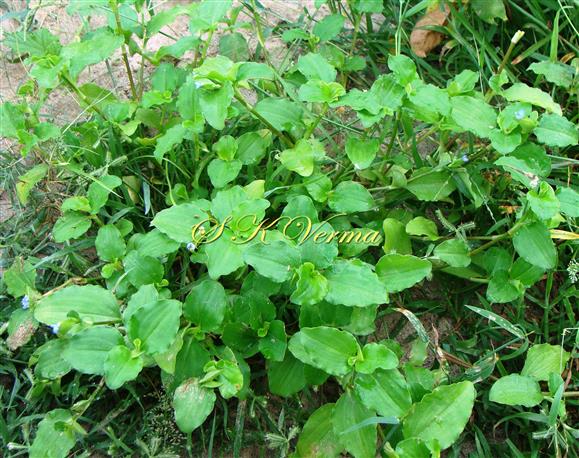
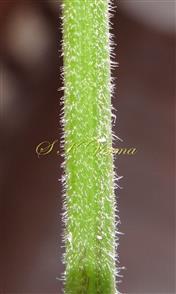
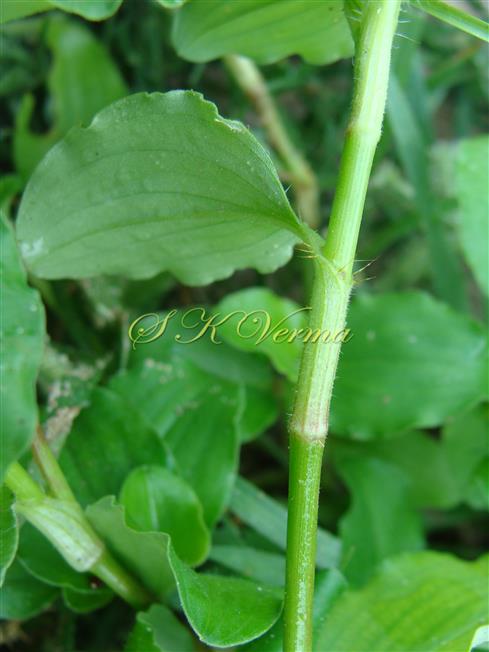
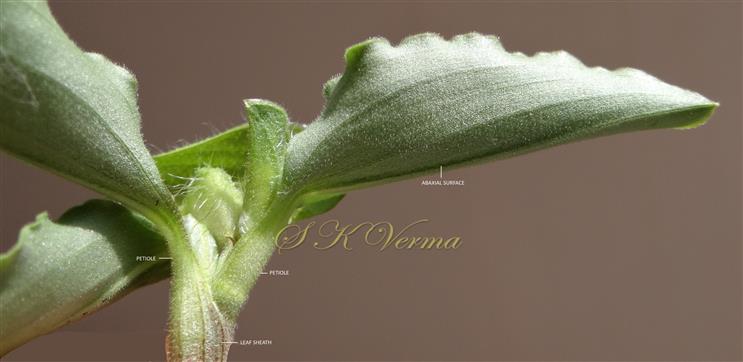
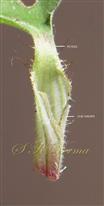
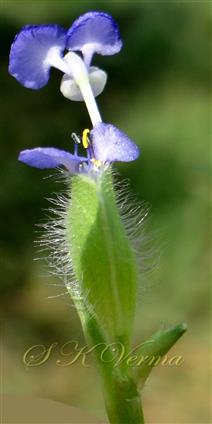
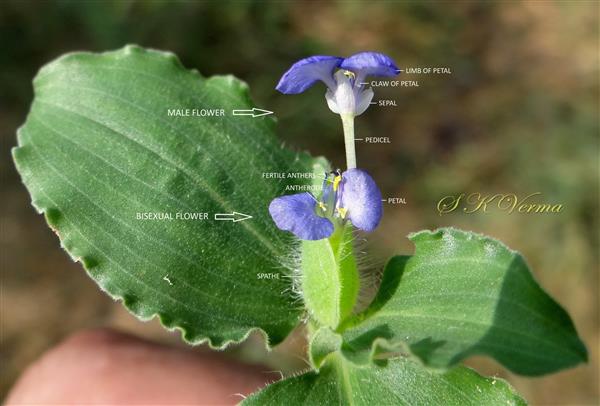

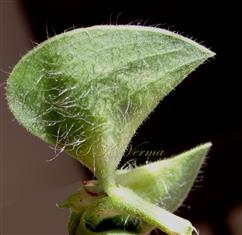
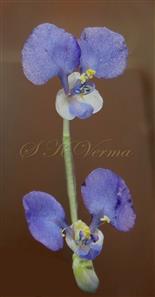
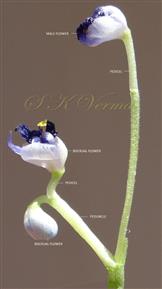

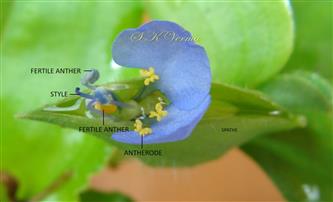
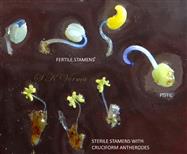
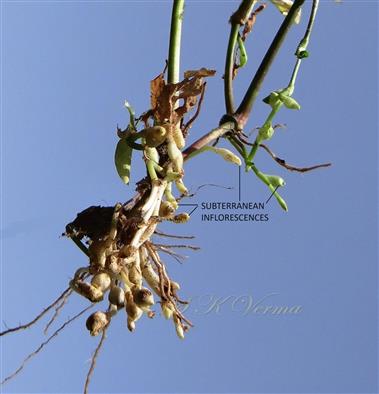
-DSC08011.jpg)
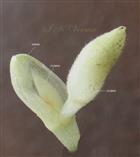
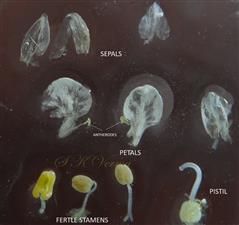
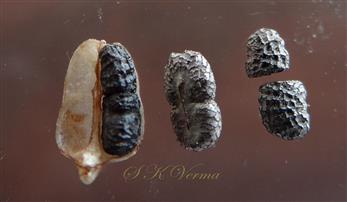
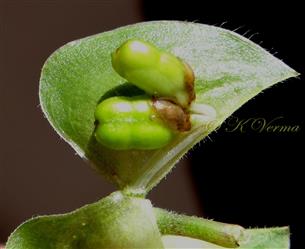
















-DSC08011.jpg)



